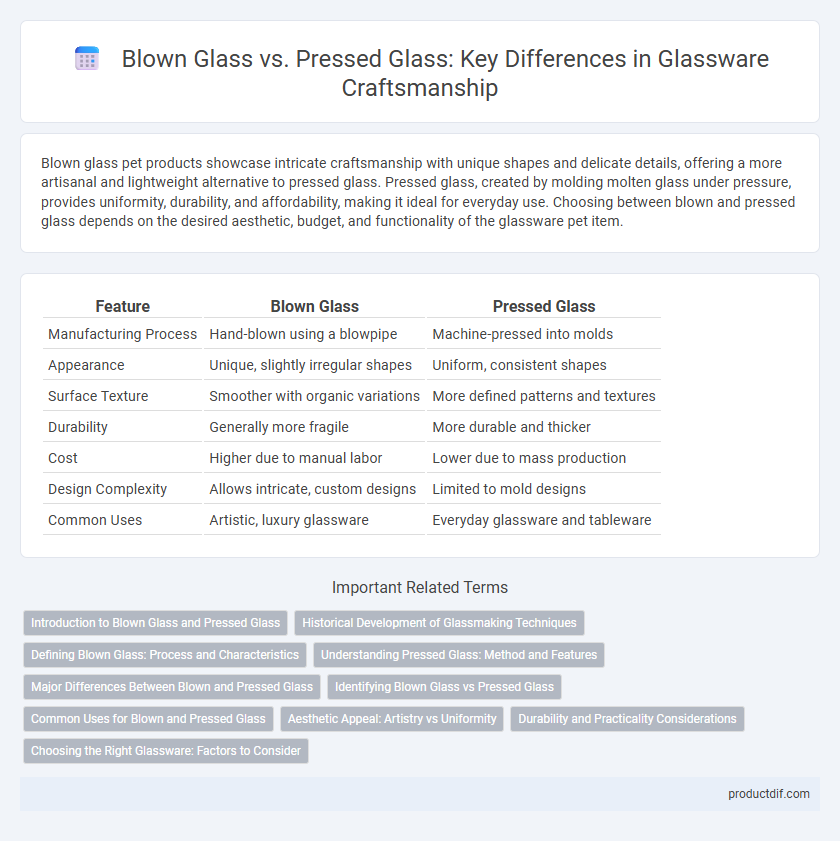Blown glass pet products showcase intricate craftsmanship with unique shapes and delicate details, offering a more artisanal and lightweight alternative to pressed glass. Pressed glass, created by molding molten glass under pressure, provides uniformity, durability, and affordability, making it ideal for everyday use. Choosing between blown and pressed glass depends on the desired aesthetic, budget, and functionality of the glassware pet item.
Table of Comparison
| Feature | Blown Glass | Pressed Glass |
|---|---|---|
| Manufacturing Process | Hand-blown using a blowpipe | Machine-pressed into molds |
| Appearance | Unique, slightly irregular shapes | Uniform, consistent shapes |
| Surface Texture | Smoother with organic variations | More defined patterns and textures |
| Durability | Generally more fragile | More durable and thicker |
| Cost | Higher due to manual labor | Lower due to mass production |
| Design Complexity | Allows intricate, custom designs | Limited to mold designs |
| Common Uses | Artistic, luxury glassware | Everyday glassware and tableware |
Introduction to Blown Glass and Pressed Glass
Blown glass is crafted by inflating molten glass into a bubble using a blowpipe, allowing for intricate shapes and unique, handcrafted designs. Pressed glass involves pressing molten glass into molds with a plunger, resulting in uniform patterns and mass production efficiency. Both methods produce distinct textures and qualities, with blown glass prized for its artistic variability and pressed glass valued for its consistency and affordability.
Historical Development of Glassmaking Techniques
Blown glass originated around 1st century BCE in the Roman Empire, revolutionizing glassmaking by enabling more intricate shapes and thinner walls compared to earlier core-formed and casting methods. Pressed glass emerged in the 19th century with the advent of industrialization, using molds and mechanical presses to mass-produce glassware efficiently and affordably. These distinct techniques reflect the technological and cultural shifts that shaped decorative and functional glass objects through history.
Defining Blown Glass: Process and Characteristics
Blown glass is crafted by inflating molten glass into a bubble through a blowpipe, allowing artisans to shape intricate and unique designs. This process results in lightweight, often irregular forms with subtle variations and a thinner wall compared to pressed glass. Characteristics of blown glass include enhanced clarity, delicate textures, and an organic aesthetic that showcases the skill of the glassblower.
Understanding Pressed Glass: Method and Features
Pressed glass is manufactured by forcing molten glass into a mold using a plunger, resulting in uniform patterns and consistent thickness. This method allows mass production with lower costs compared to blown glass, which is individually shaped by artisans. Pressed glass typically features sharper, more geometric designs and is heavier due to its density and mold-pressed formation.
Major Differences Between Blown and Pressed Glass
Blown glass is handcrafted by inflating molten glass into a bubble using a blowpipe, resulting in unique, irregular shapes and thickness variations, while pressed glass is made by pressing molten glass into molds, producing uniform and mass-produced items. Blown glass generally offers greater artistic detail and individuality, whereas pressed glass is more affordable and consistent in pattern and size. The major differences lie in production methods, cost, level of craftsmanship, and the resulting texture and clarity of the glassware.
Identifying Blown Glass vs Pressed Glass
Blown glass features subtle irregularities, such as air bubbles and uneven thickness, due to the handcrafted shaping process, while pressed glass typically exhibits uniform thickness and sharp, well-defined patterns from mold pressing. Identifying blown glass often involves checking for a pontil mark on the base, a scar left from the glassblower's rod, which is absent in pressed glass. The weight difference also aids identification; pressed glass tends to be heavier and denser because of the molding process, whereas blown glass is lighter and more fragile.
Common Uses for Blown and Pressed Glass
Blown glass is commonly used for artistic and decorative items such as vases, ornaments, and specialty drinkware due to its unique shapes and intricate patterns. Pressed glass is frequently utilized in mass-produced tableware, including plates, bowls, and everyday glassware, because of its uniformity and cost-effectiveness. Both types serve functional and aesthetic purposes, with blown glass often favored for bespoke designs and pressed glass for practical, high-volume applications.
Aesthetic Appeal: Artistry vs Uniformity
Blown glass showcases intricate artistry with unique patterns and subtle variations in color and shape, reflecting the skill of the glassblower and making each piece a distinctive work of art. Pressed glass, produced through molds, emphasizes uniformity and precision, resulting in consistent shapes and repetitive patterns ideal for mass production. The aesthetic appeal of blown glass lies in its handcrafted charm, while pressed glass offers a polished, symmetrical finish suited to functional elegance.
Durability and Practicality Considerations
Blown glass features a unique, handcrafted structure that often results in greater flexibility and resistance to chipping, making it more durable in delicate applications. Pressed glass, produced through mold pressing, exhibits uniform thickness and sturdiness, offering better resistance to breakage under everyday use and making it practical for mass-produced items. Durability considerations favor pressed glass for heavy-duty, frequent handling scenarios, while blown glass excels in aesthetic and functional resilience in artisanal or decorative contexts.
Choosing the Right Glassware: Factors to Consider
When choosing between blown glass and pressed glass, consider factors such as durability, clarity, and design intricacy. Blown glass offers unique, handcrafted artistry with subtle variations and superior clarity, ideal for decorative or high-end glassware. Pressed glass provides consistent shapes and patterns with increased strength and affordability, making it suitable for everyday use and larger production needs.
Blown Glass vs Pressed Glass Infographic

 productdif.com
productdif.com